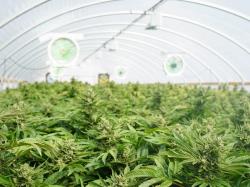CalFlowers: California Cut Flower Production Not Affected By Legal Cannabis
November 1, 2017 | 4 min to read

CAPITOLA, Calif. — A new study to understand the potential impact of cut-flower agribusiness land usage with the January 2018 legalization of cannabis production in California concludes there is no evidence it will affect the state’s ability to produce nearly 80 percent of the nation’s cut flower production. The study by Dr. Daniel Sumner of the University of California Agricultural Issues Center (AIC) at UC Davis points out that economic barriers will continue to limit how much greenhouse space is actually converted into legal cannabis production and concludes the state’s cut-flower output should generally remain stable.
Even though cannabis has been a cash crop in California for decades, licensed production in the near future will be contained by the necessary costs to comply with the new regulations and with social and political factors, according to the report commissioned by the California Association of Flower Growers & Shippers (CalFlowers). The study states that the newly legitimatized cannabis producers must pay taxes and fees, comply with state and local regulations, and while some sanctioned cannabis producers may seek to grow their crop where cut flowers are grown today, the impact is expected to be negligible.
"Our conclusion is that cannabis is not among the main issues that California’s cut flower growers need to be concerned with anytime soon and certainly not in 2018,” Sumner said.
To understand the potential impact of cannabis demand and production on the state’s cut flower producing capacity, Sumner had his team focus on licensed production expected to begin in January 2018 because it is only this new crop that represents a potential challenge to cut flower production. Despite the statewide total of 15.5 million pounds of cannabis production, the AIC estimates at most 700,000 pounds of licensed cannabis will be produced in greenhouses in California in 2018.
All of this could be grown in just approximately 6 percent of the state’s floriculture growing space and about 3 percent of its total greenhouse space. Of course, not all of the converted cannabis crop will be produced in floriculture growing space for many reasons. The direct competition for farm labor should also only have a slight impact on cut-flower production.
Michael LoBue, CalFlowers CEO said, “We commissioned the report to determine if the upcoming ‘gold rush’ with the legalization of cannabis would cut into our production capacity and found out it won’t affect our output or distribution channels. Even though greenhouses might seem like good places to grow cannabis, this report indicates that the entry costs and other factors are just too daunting to have much of an impact on an established and thriving industry like the cut-flower agribusiness.”
The study results were presented at the CalFlowers‘ biennial conference and convention Fun ‘N Sun this August in Carlsbad, Calif. Following a presentation of the findings, Sumner and a panel of CalFlowers members discussed the issues concerning flower growers and shippers.
The CalFlowers conference panel included:
-
Steve Dionne of Wafex USA, panel moderator, who has been involved in the California floral industry for over 20 years, serves on the CalFlowers Board, and has twice served as the association’s president
-
Michael A. Mellano, chairman of the board and vice president of farming for Mellano & Company, a third generation cut flower producer and distributor in San Luis Rey, Calif.
-
Martin Meskers, president of wholesale cut flower nursery Oregon Flowers, Inc., in Aurora, Ore., who brought insights as a producer in a state that is slightly ahead of California in the legalization of cannabis
-
Patrick Dahlson, CEO of Mayesh Wholesale Florist and an active participant in the floral industry who has served in the leadership of the Wholesale Florists & Florists Suppliers Association (WF&FSA) and the Society of American Florists (SAF)
- Daniel A. Sumner, Ph.D., is the Frank H. Buck Jr. Professor in the Department of Agricultural and Resource Economics at the University of California, Davis, and the Director of the University of California Agricultural Issues Center.
Sumner’s presentation and the AIC’s final report can be found on the CalFlowers’ website at http://www.cafgs.org/2017-final-report-of-cannabis-impact-on-california-cut-flowers.
About CalFlowers
The California Association of Flower Growers & Shippers (CalFlowers) is a voluntary California-based trade association comprised of nearly 200 voting members in California and 384 associate members in 47 states other than California. CalFlowers collaborates with other floral industry associations to promote the floral industry in the U.S., striving to have more Americans enjoy more flowers more often, and provides access to discount shipping programs for floral products. (www.cafgs.org)
About the Agricultural Issues Center
The University of California Agricultural Issues Center (AIC) provides identification and analysis of important issues affecting agriculture in California. AIC provides independent and objective research-based information on a range of critical, emerging agricultural issues and their significance for the economy. (https://aic.ucdavis.edu/)
Source: The California Association of Flower Growers & Shippers (CalFlowers)
